Understanding the Effect of Substrate Preheating Temperature and Track Spacing on Laser Assisted Cold Spraying of Ti6Al4V
Abstract
:1. Introduction
2. Materials and Methods
2.1. Feedstock Powder and Substrate Material
2.2. Laser-Assisted Cold Spray (LACS) System and Process Conditions
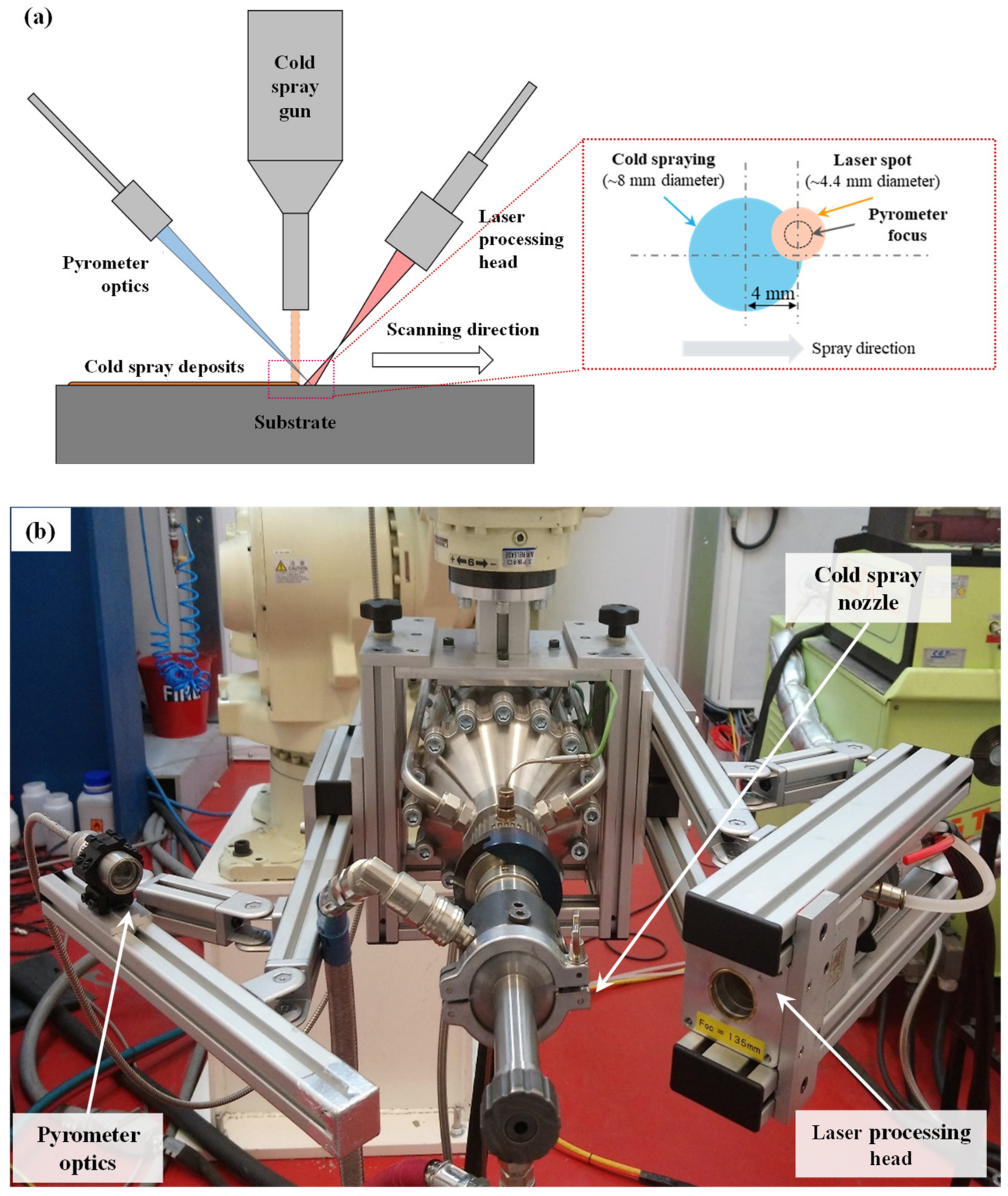
| CS system setup | Gun | CS system | Impact 5/11 |
| Process gas | N2 | ||
| Nozzle | T24-SiC | ||
| Pre-chamber | Long (128.6 mm) | ||
| Gas pressure (MPa) | 5 | ||
| Gas temperature (°C) | 1100 | ||
| Powder feeder | Dosing disk rotation speed (rpm) | 2 | |
| Powder feed rate (g/min) | 24.67 | ||
| Carrier gas flow rate (m3/hr) | 2 | ||
| Nozzle cooling medium | Water | ||
| Robot and toolpath setup | Gun traverse or scanning speed (mm/s) | 40 | |
| Track spacing (mm) | 1, 2, and 3 (Table 2) | ||
| Spray angle (°) | 90 | ||
| Standoff distance (mm) | 30 | ||
| Toolpath pattern | Horizontal raster | ||
| Laser parameters | Required surface temperature (°C) | 400, 600, and 800 (Table 2) | |
| Stand-off distance (mm) | 195 | ||
| Laser spot diameter (mm) | 4.4 | ||
| Pyrometer distance (mm) | 400 | ||
| Stages | Sample No. | Laser Substrate Preheating Temperature (°C) | Track Spacing (mm) | Type of Specimen |
|---|---|---|---|---|
| LACS 400 | 400 | - | Single-track deposition | |
| Phase 1 | LACS 600 | 600 | - | |
| LACS 800 | 800 | - | ||
| LACS 600-1 | 600 | 1 | Single-layer (multi-track) deposition with overlapping tracks. | |
| Phase 2 * | LACS 600-2 | 600 | 2 | |
| LACS 600-3 | 600 | 3 |
2.3. LACS Deposition Trials
2.3.1. Phase 1: Single-Track LACS Deposition Trials
2.3.2. Phase 2: Single-Layer Multi-Track LACS Deposition Trials
2.4. Post-Deposition Thermal Treatment
2.5. Characterisation of LACS Deposits
2.6. Residual Stress Measurements Using Incremental Center-Hole Drilling
3. Results and Discussion
3.1. Phase 1: Characterisation of Single-Track LACS Deposits
3.1.1. Surface Profilometry
3.1.2. Microstructure
3.2. Phase 2: Chracterisation of Single-Layer Multi-Track LACS Deposits
3.2.1. Surface Profilometry
3.2.2. Microstructure and Porosity
3.2.3. Phase Analysis Using X-ray Diffraction
3.2.4. Microhardness
3.3. Residual Stresses in Single-Layer LACS Deposits
3.4. Effect of Heat Treatment on the Microstructure of LACS Deposits
4. Conclusions
- For single-track specimens, the surface profiles exhibited asymmetry. The laser-assisted side of the tracks were more compact and possessed lower thicknesses compared to the non-laser-assisted side. For single-layer specimens, LACS deposits with 2 mm track spacing showed the most even distribution.
- Cross-sectional microstructure of the single-track deposits revealed intimate contact at the interfaces, showcasing extensive interfacial mixing, particularly for specimens laser preheated to substrate temperatures of 600 °C and 800 °C. For single-layer specimens, superior coating-substrate adhesion was observed at the narrowest deposition track spacing (1 mm).
- Cross-sectional area fraction of porosity values were found to be in the range of 0.37% to 0.44%, for LCAS deposits with track spacings 1 mm, 2 mm, and 3 mm; which is 81–84% lower than the porosity content in standard CS without laser preheating (2.27%).
- Average microhardness values were found to be 403 HV, 397 HV, and 388 HV, for LCAS deposits with track spacing 1 mm, 2 mm, and 3 mm, respectively. They are comparable to mill-annealed Ti6Al4V substrate (393 HV) but lower than the standard CS deposits without laser preheating (429 HV). For LACS deposits with 1 mm track spacing, hardness values were particularly high near the interface exceeding 550 HV, attributed to the formation of a localised heat-affected zone.
- Tensile bi-axial residual stresses were observed in all three LACS coatings, attributed to the elevated process gas temperature (1100 °C) and substantial heat input from laser preheating of the substrate to 600 °C. The longitudinal tensile residual stresses in the LACS coatings deposited with 1 mm, 2 mm, and 3 mm track spacings were measured as 31 MPa, 135 MPa, and 191 MPa, respectively.
- Heat treatments led to distinct microstructures in LACS coatings, including fully equiaxed or lamellar α-phase within the β-phase or a bimodal microstructure influenced by track spacing variations.
Author Contributions
Funding
Data Availability Statement
Acknowledgments
Conflicts of Interest
References
- Assadi, H.; Kreye, H.; Gärtner, F.; Klassen, T. Cold spraying—A materials perspective. Acta Mater. 2016, 116, 382–407. [Google Scholar] [CrossRef]
- Grigoriev, S.; Okunkova, A.; Sova, A.; Bertrand, P.; Smurov, I. Cold spraying: From process fundamentals towards advanced applications. Surf. Coat. Technol. 2015, 268, 77–84. [Google Scholar] [CrossRef]
- Villafuerte, J. Modern Cold Spray: Materials, Process, and Applications. In Modern Cold Spray: Materials, Process, and Applications; Springer: Berlin/Heidelberg, Germany, 2015; pp. 1–429. [Google Scholar]
- Sova, A.; Grigoriev, S.; Okunkova, A.; Smurov, I. Potential of cold gas dynamic spray as additive manufacturing technology. Int. J. Adv. Manuf. Technol. 2013, 69, 2269–2278. [Google Scholar] [CrossRef]
- Yin, S.; Cavaliere, P.; Aldwell, B.; Jenkins, R.; Liao, H.; Li, W.; Lupoi, R. Cold spray additive manufacturing and repair: Fundamentals and applications. Addit. Manuf. 2018, 21, 628–650. [Google Scholar] [CrossRef]
- Boyer, R.R. Titanium for aerospace: Rationale and applications. Adv. Perform. Mater. 1995, 2, 349–368. [Google Scholar] [CrossRef]
- Boruah, D.; Zhang, X.; McNutt, P.; Khan, R.; Begg, H. Effect of Post-Deposition Thermal Treatments on Tensile Properties of Cold Sprayed Ti6Al4V. Metals 2022, 12, 1908. [Google Scholar] [CrossRef]
- Boruah, D.; Zhang, X. Effect of Post-Deposition Solution Treatment and Ageing on Improving Interfacial Adhesion Strength of Cold Sprayed Ti6Al4V Coatings. Metals 2021, 11, 2038. [Google Scholar] [CrossRef]
- Allen, R.; Marrocco, C.M.; McNutt, T.; Koivuluoto, P.; Latokartano, H.; Vuoristo, J.; Olsson, P. A novel coaxially laser-assisted (COLA) cold spray system. In Proceedings of the International Thermal Spray Conference, ASM International, Long Beach, CA, USA, 11 May 2015; Agarwal, E.T.A., Lau, Y.-C., McDonald, A., Bolelli, G., Toma, F.-L., Concustell, A., Widener, C.A., Eds.; ASM International: Materials Park, OH, USA, 2015; pp. 210–216. [Google Scholar]
- Bray, M.; Cockburn, A.; O’Neill, W. The Laser-assisted Cold Spray process and deposit characterization. Surf. Coat. Technol. 2009, 203, 2851–2857. [Google Scholar] [CrossRef]
- Olakanmi, E.O.; Doyoyo, M. Laser-assisted cold-sprayed corrosion- and wear-resistant coatings: A review. J. Therm. Spray Technol. 2014, 23, 765–785. [Google Scholar] [CrossRef]
- Walker, M.; Howes, P.; McNutt, P.; Harvey, D. Residual stress development of laser assisted cold sprayed Ni alloy 718 coatings. In Proceedings of the ITSC 2019—Proceedings of the International Thermal Spray Conference, Yokohama, Japan, 26–29 May 2019; Azarmi, K.S.F., Lau, Y., Veilleux, J., Widener, C., Toma, F., Koivuluoto, H., Balani, K., Li, H., Eds.; ASM International: Materials Park, OH, USA, 2019. [Google Scholar]
- Li, W.; Cao, C.; Yin, S. Solid-state cold spraying of Ti and its alloys: A literature review. Prog. Mater. Sci. 2020, 110, 100633. [Google Scholar] [CrossRef]
- Perton, M.; Costil, S.; Wong, W.; Poirier, D.; Irissou, E.; Legoux, J.G.; Blouin, A.; Yue, S. Effect of pulsed laser ablation and continuous laser heating on the adhesion and cohesion of cold sprayed Ti-6Al-4V coatings. J. Therm. Spray Technol. 2012, 21, 1322–1333. [Google Scholar] [CrossRef]
- Birt, A.M.; Champagne, V.K., Jr.; Sisson, R.D., Jr.; Apelian, D. Statistically Guided Development of Laser-Assisted Cold Spray for Microstructural Control of Ti-6Al-4V. Metall. Mater. Trans. A 2017, 48, 1931–1943. [Google Scholar] [CrossRef]
- Olakanmi, E.O. Optimization of the Quality Characteristics of Laser-Assisted Cold-Sprayed (LACS) Aluminum Coatings with Taguchi Design of Experiments (DOE). Mater. Manuf. Process. 2016, 31, 1490–1499. [Google Scholar] [CrossRef]
- Christoulis, D.K.; Jeandin, M.; Irissou, E.; Legoux, J.; Knapp, W. Laser-Assisted Cold Spray (LACS). In Nd YAG Laser; Dumitras, D.C., Ed.; InTech: Rijeka, Croatia, 2012; pp. 59–96. [Google Scholar]
- Koivuluoto, H.; Milanti, A.; Bolelli, G.; Latokartano, J.; Marra, F.; Pulci, G.; Vihinen, J.; Lusvarghi, L.; Vuoristo, P. Structures and Properties of Laser-Assisted Cold-Sprayed Aluminum Coatings. Mater. Sci. Forum 2017, 879, 984–989. [Google Scholar] [CrossRef]
- Masaylo, D.; Orlov, A.; Igoshin, S. Investigation of Aluminum Composite Produced by Laser-Assisted Cold Spray Additive Manufacturing. Key Eng. Mater. 2019, 822, 534–541. [Google Scholar] [CrossRef]
- Zhang, C.; Zhang, D.; Luo, C.; Peng, W.; Zang, X. Nanosecond-pulse laser assisted cold spraying of Al-Cu aluminum alloy. Coatings 2021, 11, 267. [Google Scholar] [CrossRef]
- Olakanmi, E.O.; Tlotleng, M.; Meacock, C.; Pityana, S.; Doyoyo, M. Deposition mechanism and microstructure of laser-assisted cold-sprayed (LACS) Al-12 wt.%Si coatings: Effects of laser power. JOM 2013, 65, 776–783. [Google Scholar] [CrossRef]
- Dey, D.; Sarkar, S.; Mahata, A.; Roy Choudhury, A.; Nath, A.K. Laser assisted cold spray of 15–5 PH stainless steel in a designed and developed setup. Opt. Laser Technol. 2023, 158, 108902. [Google Scholar] [CrossRef]
- Barton, D.J.; Bhattiprolu, V.S.; Thompson, G.B.; Brewer, L.N. Laser assisted cold spray of AISI 4340 steel. Surf. Coat. Technol. 2020, 400, 126218. [Google Scholar] [CrossRef]
- Nikbakht, R.; Cojocaru, C.V.; Aghasibeig, M.; Irissou, É.; Kim, T.S.; Kim, H.S.; Jodoin, B. Cold Spray and Laser-Assisted Cold Spray of CrMnCoFeNi High Entropy Alloy Using Nitrogen as the Propelling Gas. J. Therm. Spray Technol. 2022, 31, 1129–1142. [Google Scholar] [CrossRef]
- Cojocaru, C.V.; Aghasibeig, M.; Irissou, E. NiCoCrAlX (X = Y, Hf and Si) Bond Coats by Cold Spray for High Temperature Applications. J. Therm. Spray Technol. 2022, 31, 176–185. [Google Scholar] [CrossRef] [PubMed]
- Barton, D.J.; Bhattiprolu, V.S.; Hornbuckle, B.C.; Batali, C.M.; Darling, K.A.; Thompson, G.B.; Brewer, L.N. Residual Stress Generation in Laser-Assisted Cold Spray Deposition of Oxide Dispersion Strengthened Fe91Ni8Zr1. J. Therm. Spray Technol. 2020, 29, 1550–1563. [Google Scholar] [CrossRef]
- Barton, D.J.; Hornbuckle, B.C.; Darling, K.A.; Brewer, L.N.; Thompson, G.B. Influence of surface temperature in the laser assisted cold spray deposition of sequential oxide dispersion strengthened layers: Microstructure and hardness. Mater. Sci. Eng. A 2021, 811, 141027. [Google Scholar] [CrossRef]
- Story, W.A.; Barton, D.J.; Hornbuckle, B.C.; Darling, K.A.; Thompson, G.B.; Brewer, L.N. Laser assisted cold spray of Fe-Ni-Zr oxide dispersion strengthened steel. Materialia 2018, 3, 239–242. [Google Scholar] [CrossRef]
- Tlotleng, M.; Akinlabi, E.; Shukla, M.; Pityana, S. Microstructural and Mechanical Evaluation of Laser-Assisted Cold Sprayed Bio-ceramic Coatings: Potential Use for Biomedical Applications. J. Therm. Spray Technol. 2015, 24, 423–435. [Google Scholar] [CrossRef]
- ASTM B822-17; Standard Test Method for Particle Size Distribution of Refractory Metal Powders and Related Compounds by Light Scattering. ASTM International: West Conshohocken, PA, USA, 2017.
- Boruah, D.; Robinson, B.; London, T.; Wu, H.; de Villiers-Lovelock, H.; McNutt, P.; Doré, M.; Zhang, X. Experimental evaluation of interfacial adhesion strength of cold sprayed Ti-6Al-4V thick coatings using an adhesive-free test method. Surf. Coat. Technol. 2020, 381, 125130. [Google Scholar] [CrossRef]
- Boruah, D.; Ahmad, B.; Lee, T.L.; Kabra, S.; Syed, A.K.; McNutt, P.; Doré, M.; Zhang, X. Evaluation of residual stresses induced by cold spraying of Ti-6Al-4V on Ti-6Al-4V substrates. Surf. Coat. Technol. 2019, 374, 591–602. [Google Scholar] [CrossRef]
- ISO 4288:1996; Geometrical Product Specifications (GPS)—Surface Texture: Profile Method—Rules and Procedures for the Assessment of Surface Texture. ISO: Geneva, Switzerland, 1996.
- ASTM E2109-01; Standard Test Methods for Determining Area Percentage Porosity in Thermal Sprayed Coatings. ASTM International: West Conshohocken, PA, USA, 2014.
- ASTM E384-17; Standard Test Method for Microindentation Hardness of Materials. ASTM International: West Conshohocken, PA, USA, 2017.
- ASTM E837-13a; Standard Test Method for Determining Residual Stresses by the Hole-Drilling Strain-Gage Method. ASTM International: West Conshohocken, PA, USA, 2013.
- Boruah, D.; Zhang, X.; Doré, M. Theoretical prediction of residual stresses induced by cold spray with experimental validation. Multidiscip. Model. Mater. Struct. 2019, 15, 599–616. [Google Scholar] [CrossRef]
- Boruah, D.; Zhang, X.; Doré, M. An analytical method for predicting residual stress distribution in selective laser melted/sintered alloys. In Proceedings of the 10th European Conference on Residual Stresses 2018—ECRS-10, Leuven, Belgium, 11–14 September 2018; Materials Research Proceedings. Volume 6, pp. 283–288. [Google Scholar]
- Chen, C.; Xie, Y.; Yan, X.; Yin, S.; Huang, R.; Zhao, R.; Wang, J.; Ren, Z.; Liu, M.; Liao, H. Effect of hot isostatic pressing (HIP) on microstructure and mechanical properties of Ti6Al4V alloy fabricated by cold spray additive manufacturing. Addit. Manuf. 2019, 27, 595–605. [Google Scholar] [CrossRef]
- Ghelichi, R.; Bagherifard, S.; Macdonald, D.; Fernandez-Pariente, I.; Jodoin, B.; Guagliano, M. Experimental and numerical study of residual stress evolution in cold spray coating. Appl. Surf. Sci. 2014, 288, 26–33. [Google Scholar] [CrossRef]
- Sharma, D.; Kamran, M.; Paraye, N.K.; Anant, R. Insights into the wear behaviour of electron beam melted Ti–6Al–4V alloy in the as-built and the heat-treated conditions. J. Manuf. Process. 2021, 71, 669–678. [Google Scholar] [CrossRef]

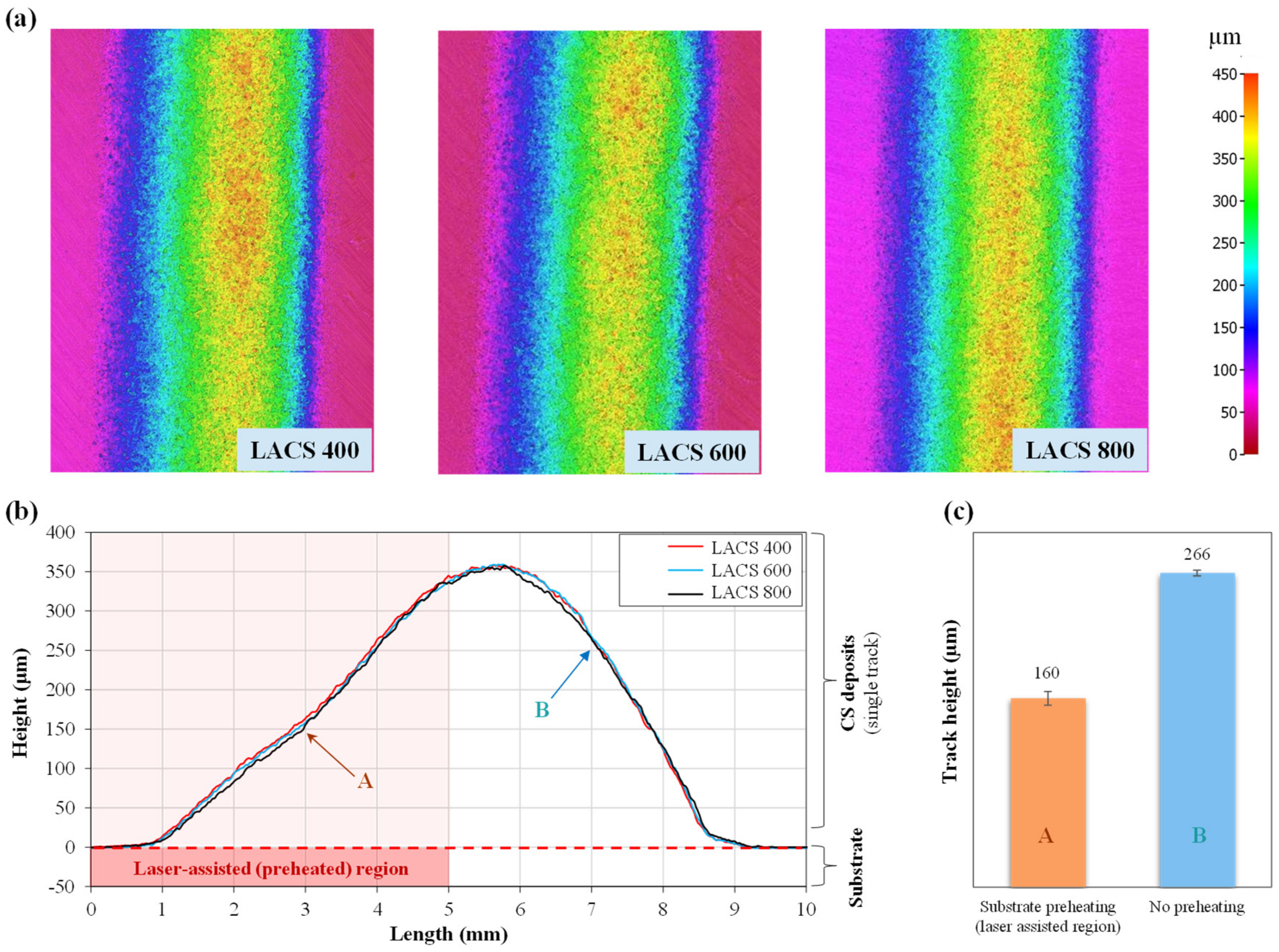

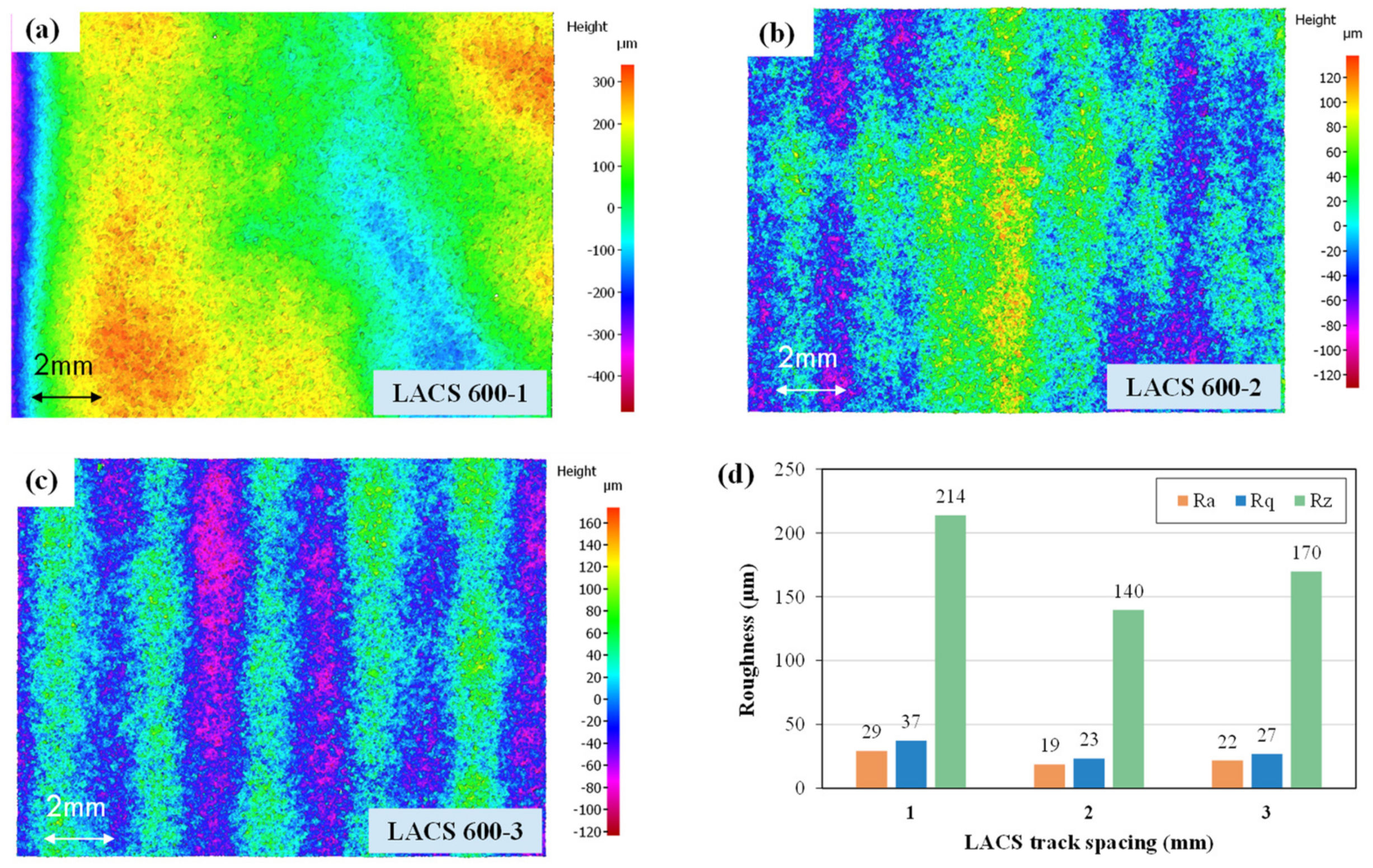
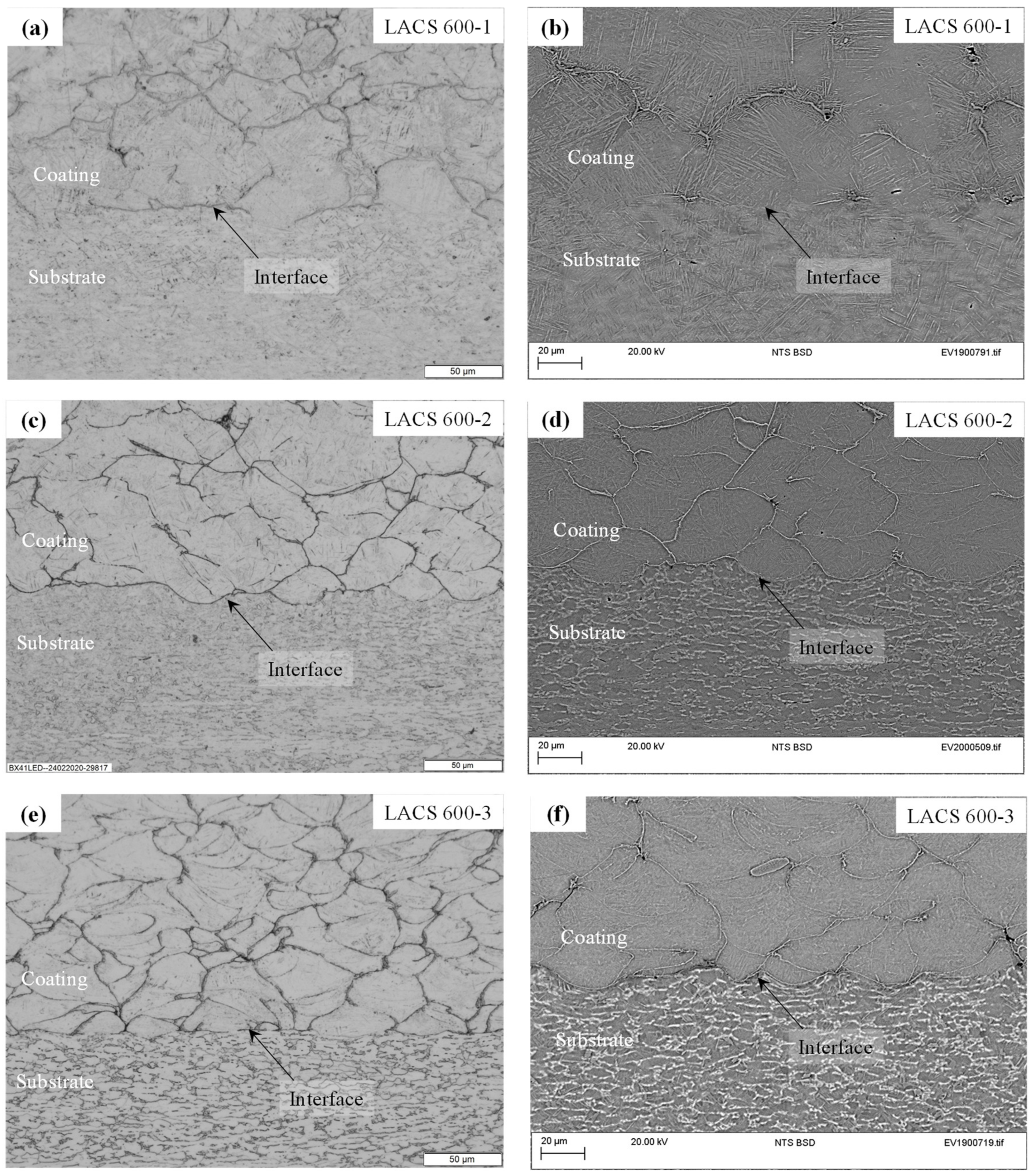

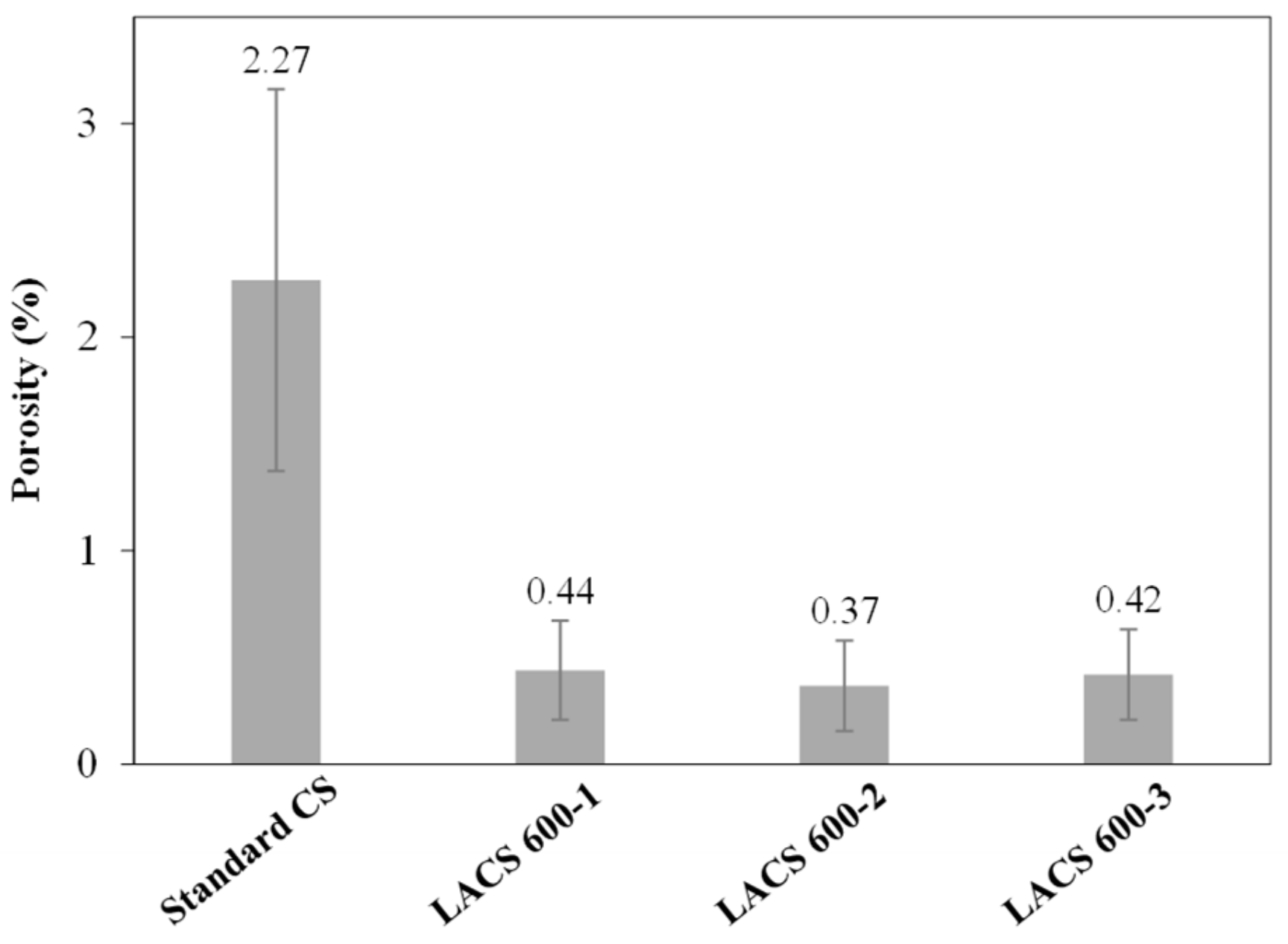
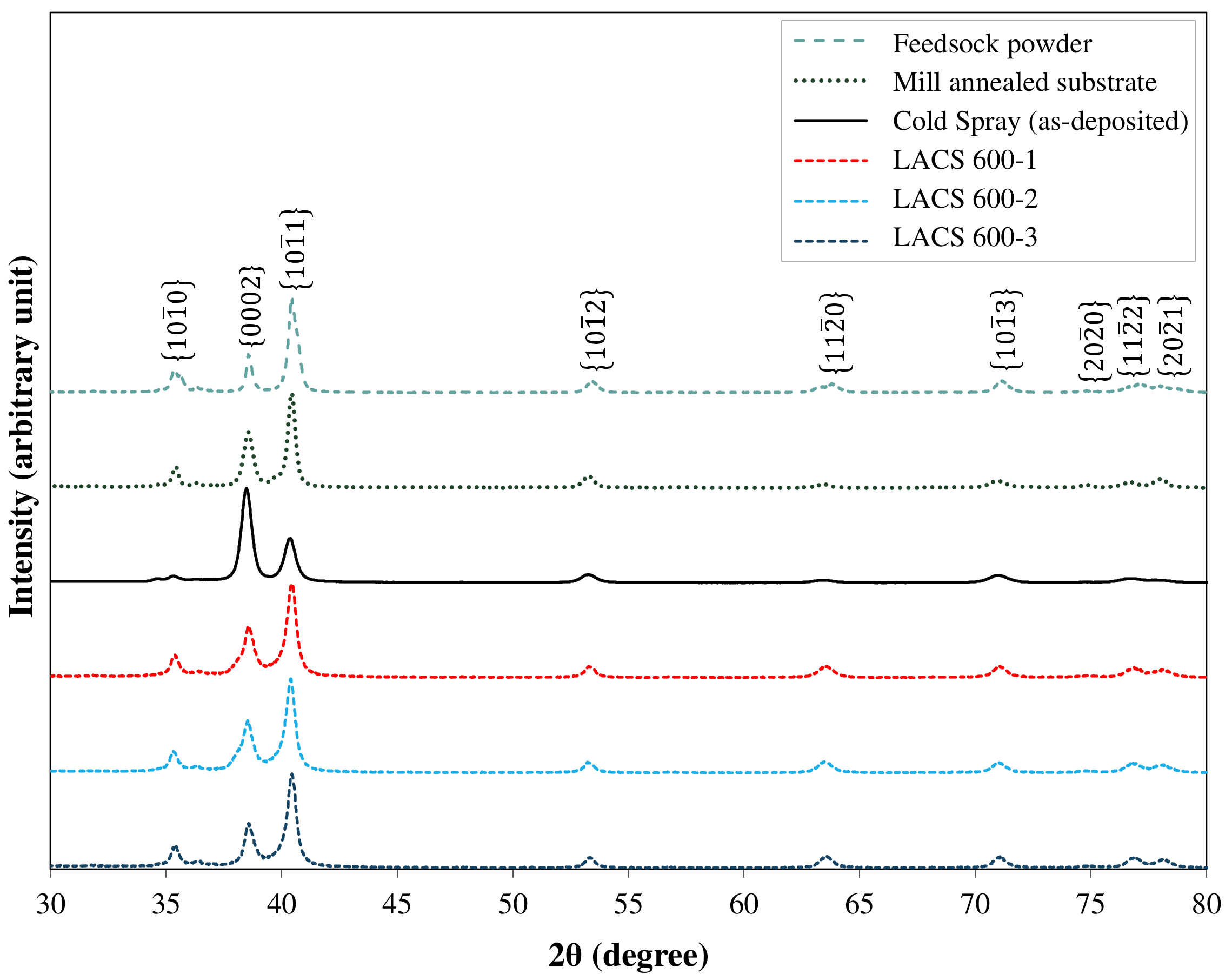
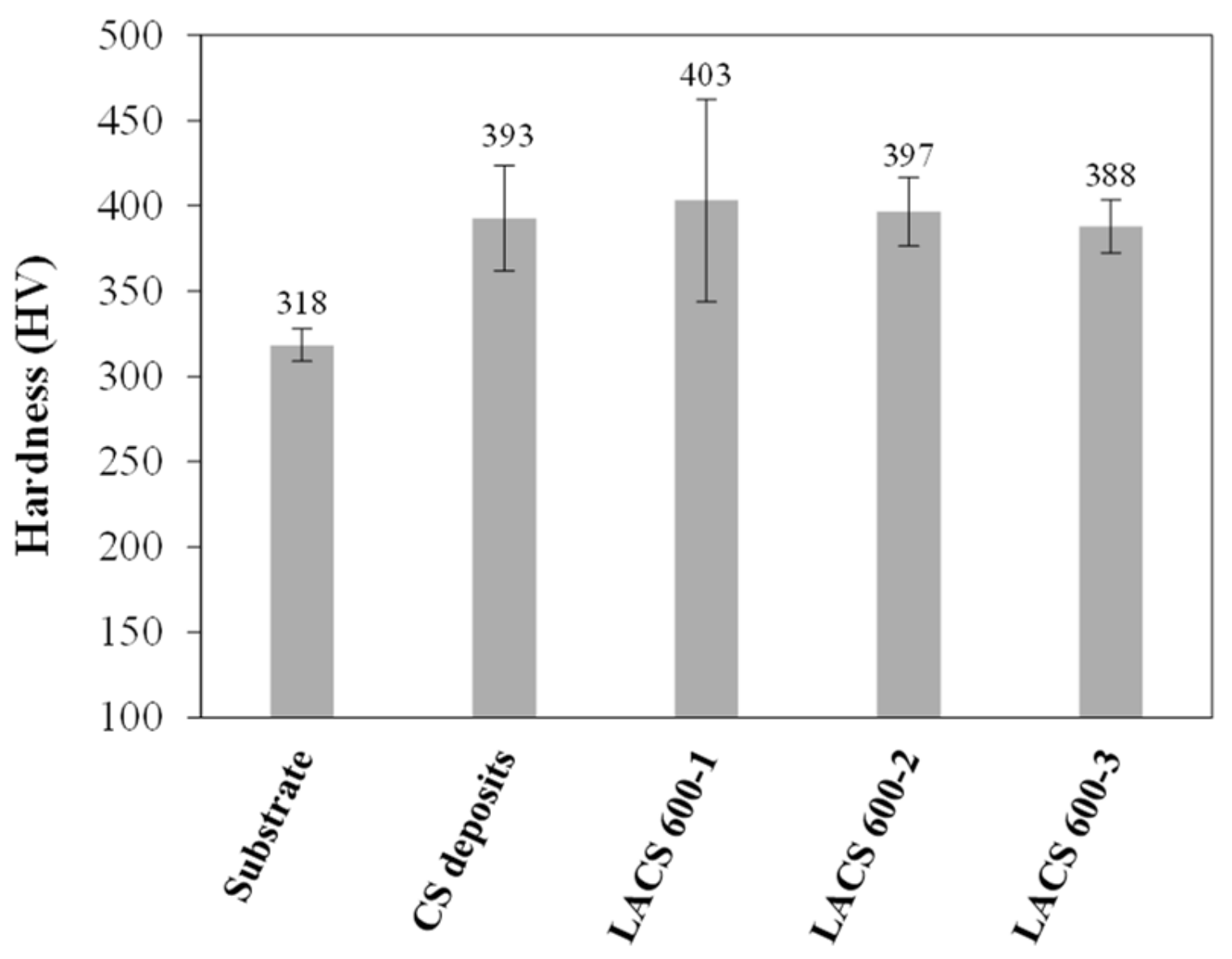
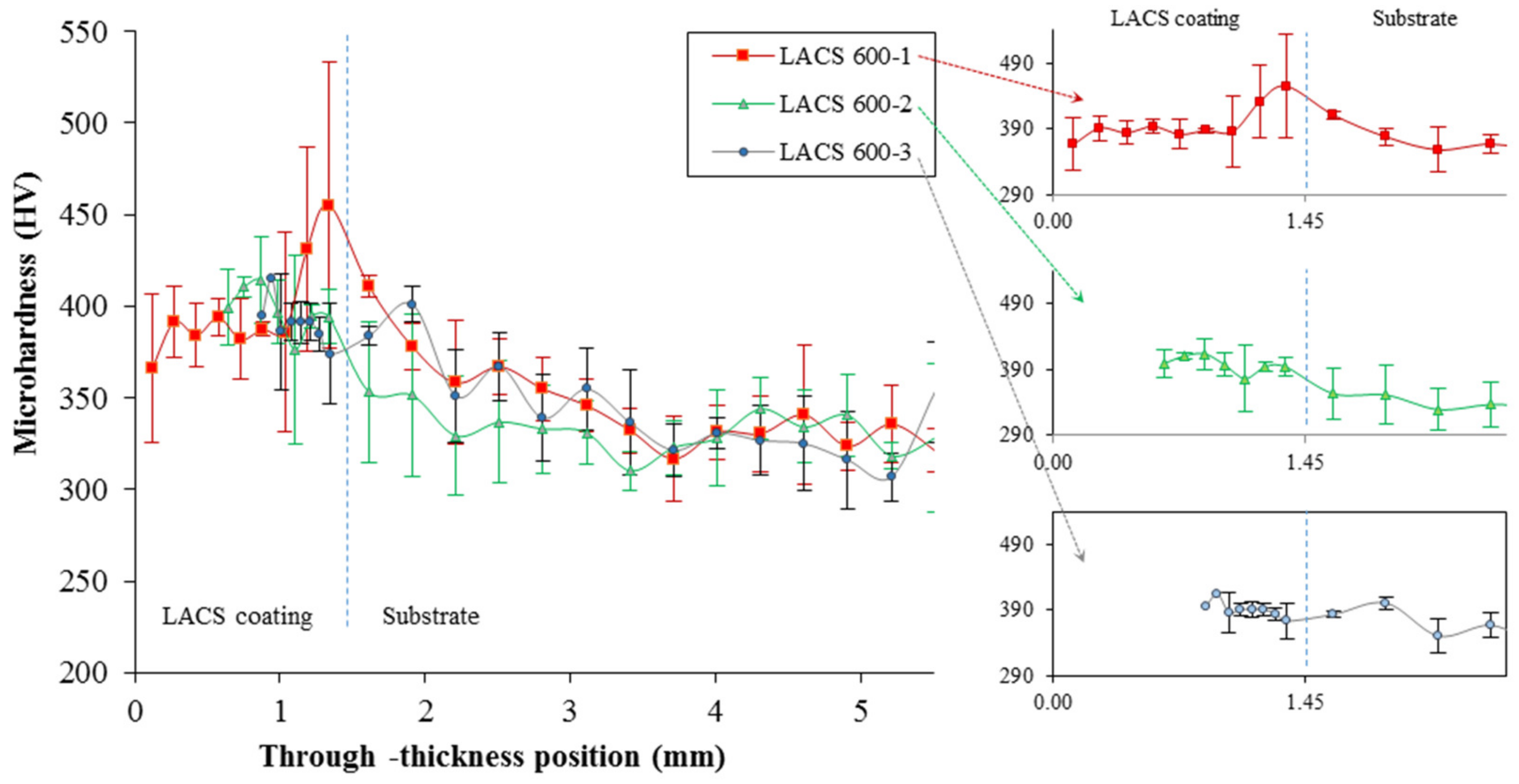
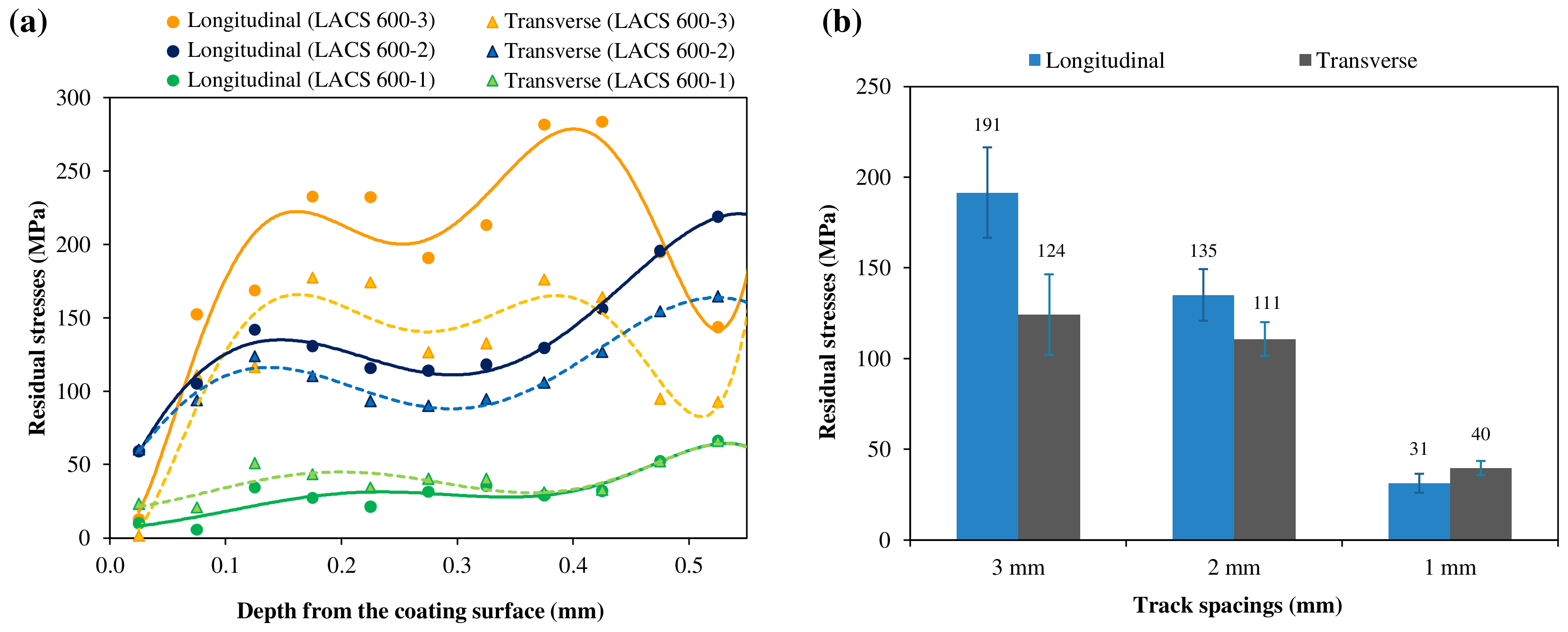
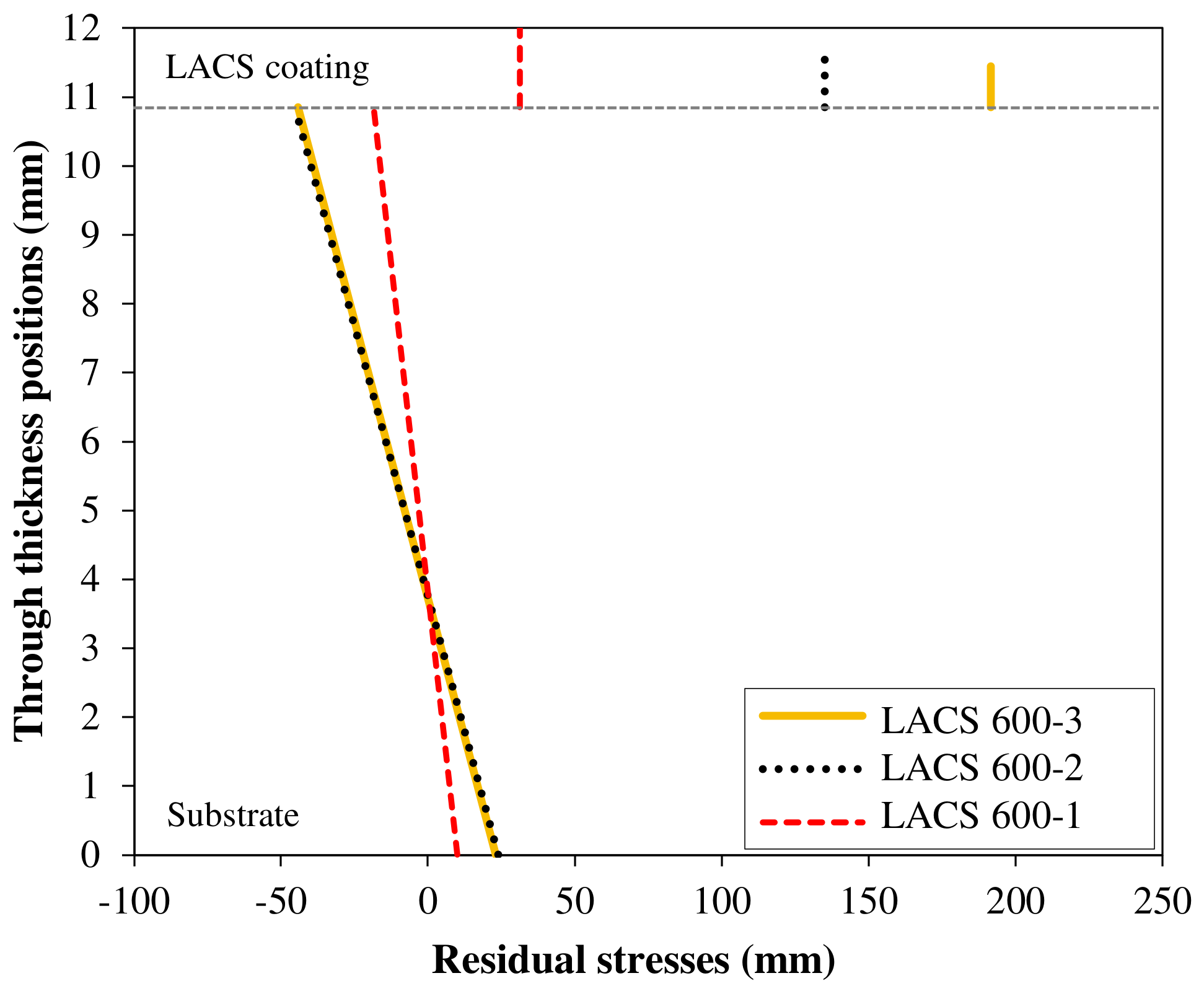
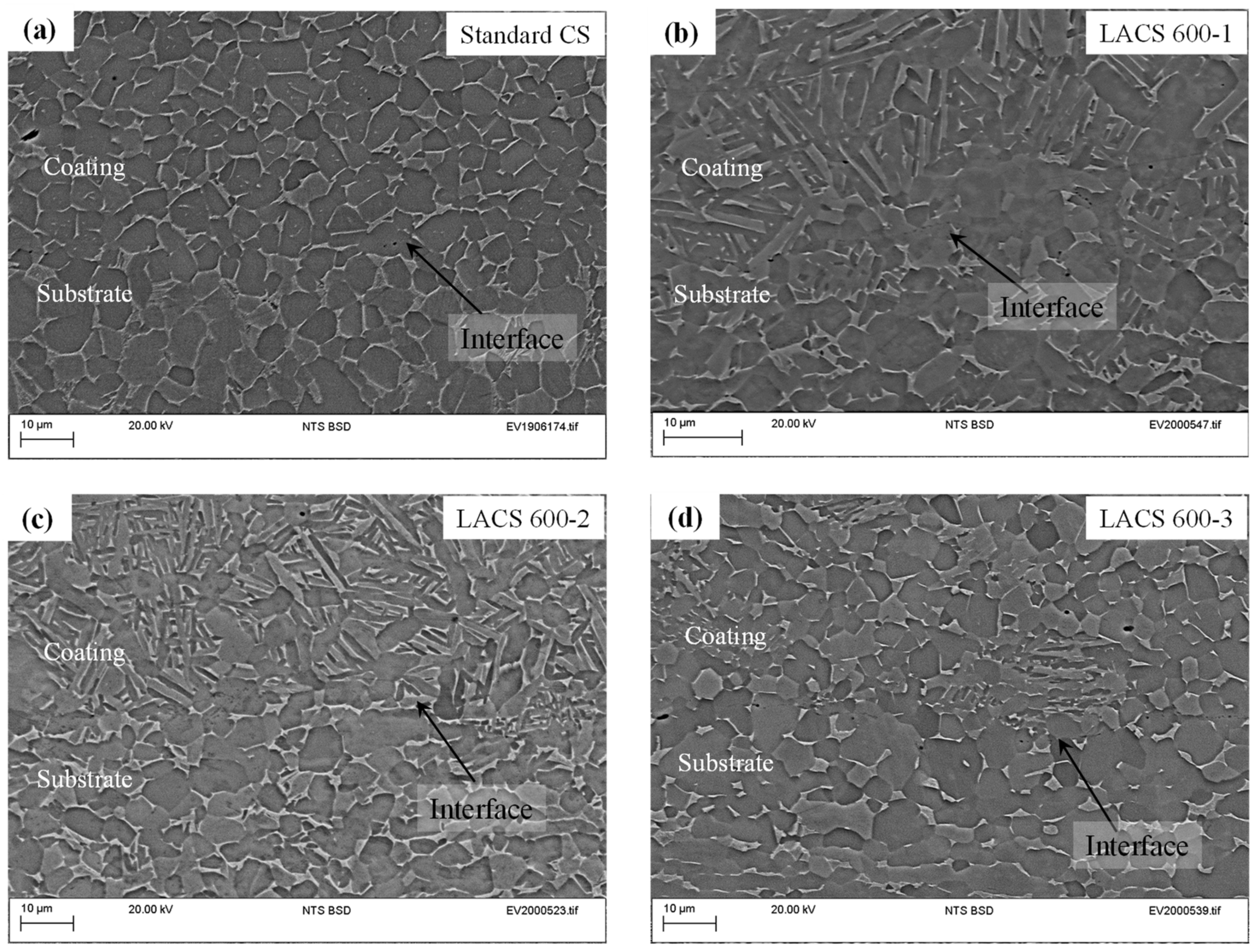
| Specimen Name | Track Spacing (mm) | Coating Thickness (mm) | No. of Layers | Substrate Thickness (mm) | Toolpath Pattern | Scanning Speed (mm/s) |
|---|---|---|---|---|---|---|
| LACS 600-1 | 1 | 1.45 | 1 | 10.85 | Horizontal raster | 40 |
| LACS 600-2 | 2 | 0.86 | ||||
| LACS 600-3 | 3 | 0.60 |
Disclaimer/Publisher’s Note: The statements, opinions and data contained in all publications are solely those of the individual author(s) and contributor(s) and not of MDPI and/or the editor(s). MDPI and/or the editor(s) disclaim responsibility for any injury to people or property resulting from any ideas, methods, instructions or products referred to in the content. |
© 2023 by the authors. Licensee MDPI, Basel, Switzerland. This article is an open access article distributed under the terms and conditions of the Creative Commons Attribution (CC BY) license (https://creativecommons.org/licenses/by/4.0/).
Share and Cite
Boruah, D.; McNutt, P.; Sharma, D.; Begg, H.; Zhang, X. Understanding the Effect of Substrate Preheating Temperature and Track Spacing on Laser Assisted Cold Spraying of Ti6Al4V. Metals 2023, 13, 1640. https://doi.org/10.3390/met13101640
Boruah D, McNutt P, Sharma D, Begg H, Zhang X. Understanding the Effect of Substrate Preheating Temperature and Track Spacing on Laser Assisted Cold Spraying of Ti6Al4V. Metals. 2023; 13(10):1640. https://doi.org/10.3390/met13101640
Chicago/Turabian StyleBoruah, Dibakor, Philip McNutt, Deepak Sharma, Henry Begg, and Xiang Zhang. 2023. "Understanding the Effect of Substrate Preheating Temperature and Track Spacing on Laser Assisted Cold Spraying of Ti6Al4V" Metals 13, no. 10: 1640. https://doi.org/10.3390/met13101640






